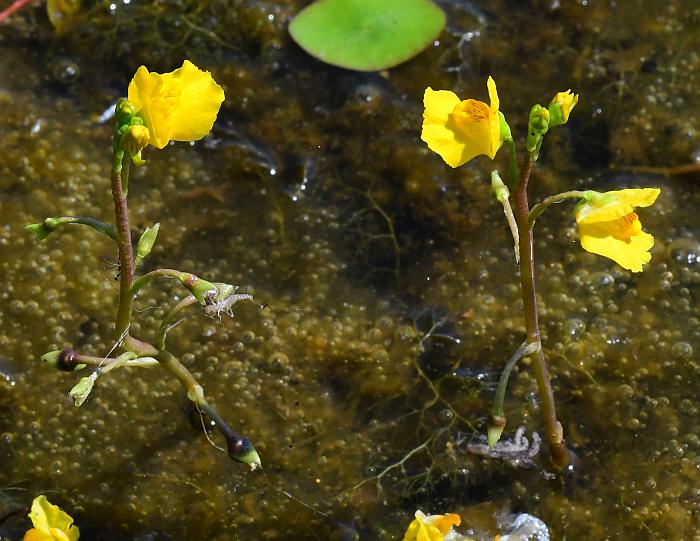Utricularia vulgaris L.
Common Bladderwort

Native
CC = 7
CW = -5
MOC = 22
© SRTurner
Utricularia vulgaris L.Common Bladderwort | |
 |
Native CC = 7 CW = -5 MOC = 22 |
© SRTurner |
|
Family - Lentibulariaceae
Leaves - Leaves mostly 15-60 mm long, sessile, usually dichotomously divided at the base, each half then more or less pinnately then dichotomously dissected into numerous threadlike segments, the segments somewhat flattened (elliptic in cross-section), tapered to minute, bristlelike tips
Inflorescence - Racemes of 6-20 flowers. Inflorescence axis glabrous. Individual flowers subtended by small bracts, these 3-7 mm long, broadly ovate.
Calyx - Calyx lobes 4-6 mm long, broadly ovate, the upper lobe sharply pointed at the tip, the lower lobe rounded to shallowly notched at the tip.
Flower - Corollas (including the spur) 12-20 mm long, yellow, the 2 lobes similar in size; the upper lip broadly ovate, entire or slightly 2-lobed; the lower lip broadly oblong-elliptic, usually slightly 2-lipped, the palate densely hairy and sometimes also glandular toward the base, often spotted or mottled red, the spur 7-12 mm long, shorter than the lower lip, conic, relatively stout and usually sharply pointed at the tip.
Fruits - Fruits globose, 5-6 mm. Seeds about 0.4 mm long, squarish in outline, strongly 4-7- angled, winged, the body smooth to finely roughened.
Flowering - May - September. Habitat - Submerged aquatic with emergent inflorescences, in ponds, sloughs, ditches, shallow stagnant water. Origin - Native to the U.S.? Relationship to Old World spp. unclear. Lookalikes - Other species of Utricularia. Other info. - These bizarre plants are carnivorous by virtue of the tiny bladders attached to the leaf segments. In the resting state, these bladders are deflated. A microscopic animal swimming in close proximity to a bladder can trigger sensory hairs, opening a trap door and allowing the bladder to suddenly inflate. The inrush of water carries the animal into the bladder, after which the trap door snaps shut. The animal is subsequently digested, providing nutrients to the plant and facilitating its survival in nutrient-poor environments. Prey organisms are mostly minute aquatic or soil borne invertebrates. Photographs taken at Marais Temps Clair Conservation Area, St. Charles County, MO, 8-17-2015, and at Duck Creek Conservation Area, 8-16-2021 and 8-20-2024 (SRTurner). |